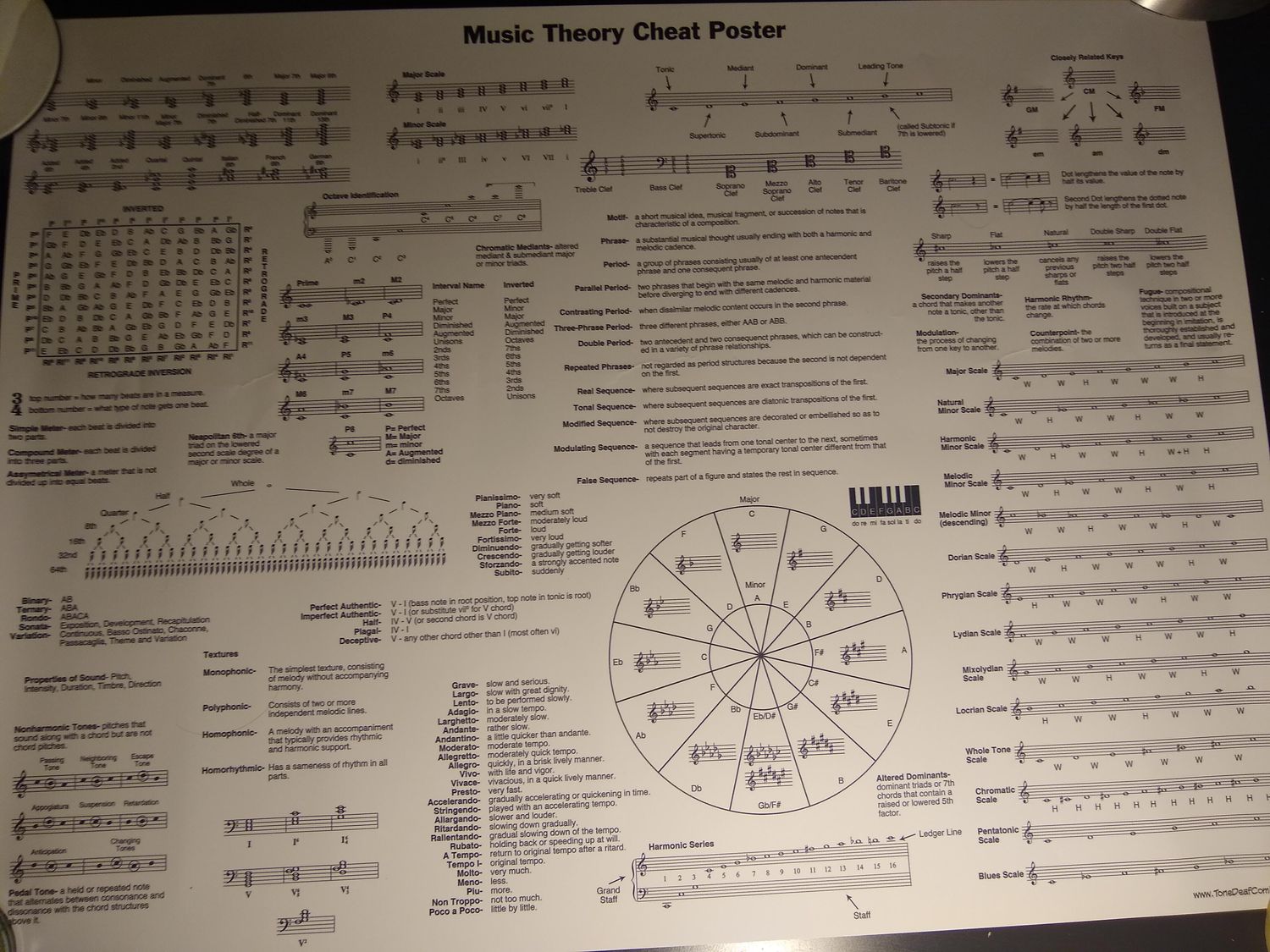Home>Production & Technology>Music Theory>How Hard Is It To Learn Music Theory For Electronic Music


Music Theory
How Hard Is It To Learn Music Theory For Electronic Music
Published: January 29, 2024
Discover the secrets behind mastering music theory for electronic music production. Unlock your creative potential with our comprehensive guide.
(Many of the links in this article redirect to a specific reviewed product. Your purchase of these products through affiliate links helps to generate commission for AudioLover.com, at no extra cost. Learn more)
Table of Contents
- Introduction
- What is Music Theory?
- Why is Music Theory Important for Electronic Music?
- Basic Concepts in Music Theory for Electronic Music
- Scales and Chords
- Melody and Harmony
- Rhythm and Tempo
- Understanding Synthesis and Sound Design
- Applying Music Theory in Electronic Music Production
- Tips for Learning Music Theory for Electronic Music
- Conclusion
Introduction
Welcome to the world of electronic music! Whether you’re a seasoned producer or just starting out, understanding music theory is crucial to creating compelling and unforgettable electronic tracks. Music theory provides the framework and language for artists to communicate, experiment, and craft their sonic visions.
Electronic music is a versatile and ever-evolving genre that encompasses a wide range of styles, from ambient and downtempo to techno and dubstep. While it may seem daunting to navigate the complexities of music theory, rest assured that with dedication and practice, you can grasp the fundamental concepts and apply them to your own productions.
In this article, we will explore the importance of music theory in electronic music and how it can enhance your creative process. We will delve into key concepts such as scales, chords, melody, harmony, rhythm, and sound design, providing you with a solid foundation to take your electronic music production skills to the next level.
Whether you’re aiming to compose catchy melodies, design compelling soundscapes, or master innovative rhythms, understanding music theory will unlock a world of possibilities and allow you to express yourself more effectively as an electronic musician. So, let’s dive in and discover the fascinating world of music theory for electronic music!
What is Music Theory?
Music theory is the study of the principles and practices that govern the creation and understanding of music. It encompasses a variety of elements, including melody, harmony, rhythm, form, and structure. Music theory provides musicians with a set of tools and guidelines to compose, analyze, and communicate musical ideas.
In essence, music theory acts as a language for musicians, allowing them to communicate their musical thoughts and ideas effectively. It provides a framework to understand how musical elements interact with each other and how they can be combined to create a cohesive and aesthetically pleasing composition.
For electronic musicians, having a solid understanding of music theory is particularly important. While electronic music often incorporates innovative production techniques and digital technology, the core principles of music theory still apply. It forms the foundation on which electronic tracks are built, helping producers craft harmonies, melodies, and rhythms that resonate with listeners.
Music theory also plays a crucial role in song arrangements and structure. Knowing how to create dynamic build-ups, breakdowns, and transitions is essential to creating a captivating journey for the listener. Additionally, understanding different musical genres’ conventions and techniques can aid in composing within specific styles.
It’s important to note that while music theory provides guidelines and concepts, it is not a set of rigid rules. The beauty of music is found in its ability to bend and break traditional theories. Innovation often stems from challenging traditional norms and pushing the boundaries of what is considered musically acceptable.
Learning music theory not only enhances your understanding of how music is constructed but also allows you to communicate and collaborate with other musicians more effectively. It empowers you to analyze and appreciate music on a deeper level, enabling you to make more informed decisions in your own compositions.
Now that we have explored what music theory entails, let’s delve into why it is crucial for electronic musicians to have a solid grasp of these concepts.
Why is Music Theory Important for Electronic Music?
Music theory is essential for electronic musicians for several reasons. Here are a few key points highlighting the importance of music theory in the realm of electronic music:
1. Creating Harmonically Pleasing Tracks: Understanding music theory helps electronic musicians create harmonically rich compositions. Knowing which chords and notes work well together allows for more engaging and melodic progressions. Whether you’re producing ambient soundscapes or energetic dance tracks, a solid foundation in music theory will enable you to create harmonically pleasing arrangements.
2. Crafting Memorable Melodies: Melody is a central element in electronic music. Having a grasp of scales, intervals, and melodic patterns will help you create captivating, memorable melodies that resonate with your audience. Music theory provides insights into how melodies can evoke certain emotions and connect with listeners on a deeper level.
3. Developing Expressive Harmonic Progressions: Music theory empowers electronic musicians to experiment with various chord progressions to evoke specific moods or atmospheres. By understanding chord functions and the relationship between different chords, you can create harmonic progressions that enhance the emotional impact of your tracks.
4. Mastering Rhythm and Groove: Electronic music relies heavily on rhythm and groove. Music theory provides a solid foundation for understanding rhythmic patterns, time signatures, and syncopation. This knowledge allows you to create infectious beats and intricate rhythmic structures that keep the energy flowing and the crowd dancing.
5. Enhancing Sound Design: Sound design is a vital aspect of electronic music production. Having a solid understanding of music theory helps you choose the right sounds and manipulate them in a way that complements the overall composition. By understanding how different frequencies interact and the principles of harmony, you can craft sounds that fit seamlessly into your tracks.
6. Collaborating and Communicating with Musicians: Music theory acts as a universal language for musicians. When collaborating with other musicians, having a shared understanding of music theory eases communication and enhances the creative process. It allows you to effectively convey your ideas and contribute meaningfully to collaborative projects.
Overall, mastering music theory in the context of electronic music provides you with a solid foundation to explore your creativity, elevate your compositions, and connect deeply with your audience. It empowers you to make informed decisions throughout the production process and opens up new possibilities for sonic exploration.
Now that we understand the importance of music theory in electronic music, let’s delve into some fundamental concepts to get you started.
Basic Concepts in Music Theory for Electronic Music
When diving into music theory for electronic music production, there are several key concepts that you should familiarize yourself with. These concepts will serve as the building blocks for your compositions and allow you to create cohesive and musically pleasing tracks. Here are the basic concepts to get you started:
1. Scales: Scales are a collection of notes arranged in ascending or descending order. They provide the foundation for melodies, harmonies, and improvisation. Common scales used in electronic music include the major scale, natural minor scale, and pentatonic scale. Understanding scales will help you create melodies that fit harmonically with your chosen key and evoke a specific emotional quality.
2. Chords: Chords are formed by stacking multiple notes on top of each other. They create the harmonic foundation of a track. Common chord types used in electronic music include major chords, minor chords, and seventh chords. Knowing how to construct and use chords will enable you to create harmony and add depth to your compositions.
3. Melody: Melody is the main musical line or theme that stands out in a composition. It is created using a combination of notes from a particular scale. Crafting memorable melodies involves understanding concepts such as intervals, phrasing, and rhythmic patterns. Experimenting with different melodic ideas will bring uniqueness and catchiness to your electronic music tracks.
4. Harmony: Harmony refers to the combination of chords and how they interact with each other. It adds depth and richness to your tracks. Understanding harmonic progressions and chord functions will enable you to create movements and tension within your compositions.
5. Rhythm: Rhythm is a fundamental element in electronic music. It determines the groove, energy, and overall feel of your tracks. Mastering rhythmic patterns, beats, and syncopation will allow you to create compelling rhythms that keep listeners engaged and moving.
6. Form and Structure: Form and structure refer to the organization and arrangement of different sections in a track. This includes aspects such as intros, verses, choruses, bridges, and outros. Understanding song structures and how to create cohesive transitions will help you craft tracks that captivate your audience from start to finish.
By familiarizing yourself with these basic concepts, you’ll have a solid foundation to start creating your own electronic music compositions. However, keep in mind that these are just the starting points, and as you progress in your musical journey, you’ll encounter more advanced concepts and techniques to further enhance your skills.
In the next sections, we’ll explore specific aspects of music theory that are particularly relevant in electronic music production, such as scales and chords, melody and harmony, rhythm and tempo, and the world of synthesis and sound design. These concepts will help you take your electronic music production to the next level.
Scales and Chords
Scales and chords are fundamental elements in music theory and play a crucial role in creating melodies, harmonies, and overall musical structure. Understanding scales and chords is essential for electronic musicians to craft musically pleasing compositions. Let’s delve into these concepts:
Scales: A scale is a series of notes arranged in ascending or descending order. It provides the basis for melodies and harmonies. In electronic music, some commonly used scales include the major scale, natural minor scale, and pentatonic scale. Each scale has a unique set of intervals between the notes, which determines its distinct tonality and emotional quality.
When using a scale, it is important to establish a root note as the tonal center and build your melodies and harmonies around it. This creates a cohesive and musically satisfying foundation for your tracks.
Chords: Chords are formed by playing multiple notes simultaneously. They are built using particular intervals within a scale. In electronic music, chords are often constructed using triads (three-note chords) or extended chords (chords with additional notes). Common chord types include major, minor, diminished, and augmented chords.
Chords provide the harmonic backbone of a composition. They can create tension and release, add depth and color to the music, and assist in establishing the overall mood. Understanding how to construct and use chords effectively will enable you to create rich and captivating harmonic progressions in your electronic music.
One approach to creating chord progressions is to start with a scale and select specific notes from that scale to form chords. For example, in the key of C major, the C major chord (root note, major third, and perfect fifth) and the A minor chord (root note, minor third, and perfect fifth) are commonly used.
Experimenting with different chord inversions, chord voicings, and progressions will help you create unique and captivating harmonies in your tracks. Additionally, learning about chord extensions and alterations can add complexity and interest to your chord progressions.
Understanding scales and chords will allow you to create melodies that fit harmonically with your chosen key and build harmonies that evoke specific emotions in your electronic music compositions. They form the core foundation of your tracks and provide the framework for further musical exploration.
In the next section, we’ll explore melody and harmony further, delving into the techniques to create captivating musical lines and patterns that will enhance your electronic music productions.
Melody and Harmony
Melody and harmony are integral elements in music, bringing depth and emotion to compositions. In electronic music, understanding how to create compelling melodies and harmonies is essential for creating memorable and impactful tracks. Let’s explore these concepts:
Melody: Melody refers to the main musical line or theme that stands out in a composition. It is a sequence of notes arranged in a specific order. Melodies create the memorable hooks that resonate with listeners and define the character of a track. Developing strong melodies involves understanding concepts such as intervals, phrasing, and rhythm.
When creating a melody, it’s important to consider the key and scale of the track. By selecting notes from the scale and exploring different rhythm patterns, you can craft melodies that fit harmonically with the underlying chords and evoke specific emotions. Experimenting with melodic contour, dynamics, and articulation can add depth and expressiveness to your electronic music compositions.
Harmony: Harmony refers to the combination of chords and how they interact with each other. It provides the foundation for creating depth and richness in a composition. Harmonies can create tension, release, and movement within a track. Understanding chord progressions, chord inversions, and chord extensions allows you to create harmonically interesting and musically satisfying arrangements.
When harmonizing a melody, you can select chords that fit the underlying scale and create a harmonically supportive accompaniment. Exploring different chord voicings and inversions can add variety and interest to your harmonic progression. Additionally, understanding chord functions and how to create chord progressions that flow smoothly can heighten the emotional impact of your electronic music.
Combining melody and harmony effectively involves finding a balance between the two. The melody should complement the underlying chords, creating a cohesive and pleasing musical structure. Experimenting with melodic motifs, counterpoint, and harmonic substitutions can lead to unique and captivating compositions.
Remember, melody and harmony are not limited to individual elements but rather work together to create a cohesive musical experience. They can evoke different emotions, capture the listener’s attention, and make your electronic music stand out.
As you continue to develop your music theory skills, explore techniques such as modulation, harmonic tension, and modal interchange to further enhance the depth and complexity of your melodies and harmonies in electronic music.
In the next section, we’ll shift our focus to rhythm and tempo, exploring how they contribute to the energy and groove of electronic music tracks.
Rhythm and Tempo
Rhythm and tempo are foundational elements of music, and they play a crucial role in the energy and groove of electronic music. Understanding how to manipulate rhythm and tempo allows you to create captivating and dynamic tracks. Let’s explore these concepts further:
Rhythm: Rhythm refers to the pattern and arrangement of sounds and silences over time. In electronic music, rhythm is often created through the use of drum patterns, percussive elements, and melodic elements with rhythmic characteristics. Developing strong and engaging rhythms is essential to get people moving and dancing to your tracks.
Experimenting with different drum patterns, syncopation, accents, and variations can add complexity and interest to your rhythms. Understanding concepts such as time signatures, note durations, and subdivisions allows you to create intricate and engaging rhythmic structures in your electronic music compositions.
Tempo: Tempo refers to the speed or pace of a musical piece. It is typically measured in beats per minute (BPM). The tempo you choose sets the overall feel and energy of your track. Faster tempos often create a high-energy and intense atmosphere, while slower tempos can evoke a more relaxed and atmospheric mood.
Choosing the right tempo for your electronic music requires experimentation and consideration of the desired emotional impact. Different styles and subgenres of electronic music have their characteristic tempos. For example, techno typically ranges from 120 to 130 BPM, while drum and bass can range from 160 to 180 BPM.
Additionally, incorporating tempo variations within your tracks can add dynamic shifts and create more dramatic moments. Gradually increasing or decreasing the tempo can create tension and anticipation, enhancing the overall impact of your electronic music.
Rhythm and tempo work hand in hand to create the driving force and groove in your electronic music tracks. They dictate how the elements of your composition interact with each other, providing a rhythmic framework for melodies, harmonies, and overall sound design.
By experimenting with different rhythmic patterns, subdivisions, and tempos, you can create unique and captivating compositions that keep listeners engaged and immersed in your electronic music.
In the next section, we’ll explore the importance of understanding synthesis and sound design in electronic music production.
Understanding Synthesis and Sound Design
Synthesis and sound design are integral aspects of electronic music production. They involve creating and manipulating sounds to shape the sonic landscape of your tracks. Understanding the principles of synthesis and sound design allows you to craft unique and captivating sounds that define your electronic music. Let’s dive into these concepts:
Synthesis: Synthesis is the process of generating sound electronically. It involves combining different waveforms, modifying them using filters and envelopes, and manipulating parameters to create a vast range of sounds. There are various synthesis techniques used in electronic music, including subtractive synthesis, wavetable synthesis, frequency modulation (FM) synthesis, and granular synthesis.
Each synthesis technique offers different possibilities for sound creation, allowing you to shape the timbre, texture, and character of your sounds. By understanding the principles behind each synthesis technique, you can design sounds that are unique and tailored to fit your artistic vision.
Sound Design: Sound design refers to the process of creating and manipulating sounds to fit within a specific musical context. It involves using synthesis techniques, effects processing, and sampling to craft sounds that complement your melodies, harmonies, and rhythms. Sound design can range from designing intricate synth patches to manipulating samples and creating atmospheric textures.
When it comes to sound design, experimentation is key. Dive into the parameters of your chosen synthesizer, explore the different modulation possibilities, and tailor the sound to fit the desired mood, style, and emotion of your electronic music. Additionally, effects processing such as reverb, delay, and modulation effects can add depth and spatialization to your sounds.
Developing sound design skills allows you to create signature sounds that set you apart as an electronic musician. It enables you to shape a sonic identity and create an immersive listening experience for your audience.
Understanding synthesis and sound design not only allows you to create your own unique sonic palette, but it also gives you the ability to deconstruct existing sounds and learn how to recreate them. By analyzing and recreating sounds from your favorite tracks, you can gain valuable insights into the techniques employed by other artists and incorporate those techniques into your own productions.
As you continue to explore synthesis and sound design, you’ll discover new textures, tones, and possibilities for creating captivating and innovative electronic music.
In the next section, we’ll discuss how to apply music theory in your electronic music production process, helping you bring all these concepts together to create cohesive and engaging tracks.
Applying Music Theory in Electronic Music Production
Once you have a solid understanding of music theory concepts, it’s time to apply them in your electronic music production process. By incorporating music theory into your workflow, you can create tracks that are musically cohesive, harmonically rich, and emotionally impactful. Here are some ways to apply music theory in your electronic music production:
1. Creating Melodies and Harmonies: Use your knowledge of scales, chords, and progressions to craft captivating melodies and harmonies. Experiment with different scale degrees, chord inversions, and progressions to create unique and memorable musical elements.
2. Chord Progressions and Song Structure: Develop interesting chord progressions that flow smoothly and evoke the desired emotional response. Use your understanding of harmony and structure to create engaging song arrangements, with sections such as intros, verses, choruses, bridges, and outros.
3. Applying Rhythmic Techniques: Utilize rhythmic concepts such as syncopation, varied drum patterns, and accents to create dynamic and engaging rhythms. Experiment with different subdivisions and explore the interplay between rhythmic elements to bring energy and groove to your tracks.
4. Sound Design and Synthesis: Employ your understanding of synthesis techniques and sound design principles to create unique and expressive sounds. Shape the timbre and texture of your sounds to enhance the overall mood and character of your tracks.
5. Use Effects to Enhance Musicality: Apply effects such as reverb, delay, and modulation to add depth, space, and movement to your sounds. Use them tastefully to enhance the musicality of different elements within your tracks.
6. Collaborate and Seek Feedback: Engage with other musicians and producers to collaborate and gain feedback on your work. Sharing your musical ideas and learning from others can provide fresh perspectives and new insights on how to apply music theory effectively in your electronic music production.
Remember, while it’s essential to apply music theory in your production process, it’s also crucial to maintain creativity and explore innovative approaches. Music theory serves as a foundation to guide your creative decisions, but it shouldn’t limit your experimentation and willingness to push boundaries.
By consistently applying music theory principles and techniques, you’ll develop a stronger sense of musicality and create electronic music that resonates with both you and your audience.
In the final section, we’ll provide some tips to help you further develop your music theory skills and continue your journey as an electronic musician.
Tips for Learning Music Theory for Electronic Music
Learning music theory can be a rewarding and exciting journey that opens up new possibilities in your electronic music production. Here are some tips to help you effectively learn and apply music theory concepts:
1. Start with the Basics: Begin by familiarizing yourself with the fundamental concepts of music theory, such as scales, chords, rhythm, and melody. Build a solid foundation from which you can expand your knowledge and understanding.
2. Hands-On Practice: Apply what you learn by actively practicing and experimenting with music theory concepts in your own compositions. The more you practice, the more comfortable and proficient you will become.
3. Analyze Music You Love: Analyze tracks from your favorite electronic musicians. Identify the scales, chords, and progressions they use. This will not only deepen your appreciation of the music but also provide inspiration and insight into effective music theory application.
4. Utilize Online Resources: Take advantage of the wealth of online resources available. From tutorials and courses to forums and communities, there are plenty of platforms where you can learn and engage with fellow electronic musicians.
5. Experiment with Different Genres: Explore various electronic music genres and their specific music theory conventions. By experimenting with different genres, you’ll gain a broader understanding of how music theory can be applied in diverse musical contexts.
6. Collaborate with Other Musicians: Collaborating with other musicians can provide valuable opportunities for learning and growth. Collaborative projects allow you to apply music theory in a practical setting, learn from others’ perspectives, and broaden your musical horizons.
7. Break the Rules Occasionally: While it’s important to have a solid understanding of music theory principles, don’t be afraid to break the rules and experiment. Innovation often comes from challenging traditional norms and pushing the boundaries of what is considered “correct” in music theory.
8. Practice Active Listening: Develop your ear and train yourself to actively listen to music. Pay attention to the melodies, harmonies, rhythms, and other musical elements. This practice will deepen your understanding of music theory and help you identify common patterns and techniques used in electronic music.
9. Stay Consistent: Learning music theory takes time and dedication, so make it a regular part of your practice routine. Set aside dedicated time each day or week to study and apply music theory concepts to your electronic music production.
10. Have Fun and Be Creative: Above all, enjoy the process of learning music theory and applying it to your electronic music. Let your creativity guide you, and don’t be afraid to experiment and explore new sounds and ideas.
Remember, learning music theory is a continual journey, and it’s perfectly normal to encounter challenges along the way. Embrace those challenges, stay persistent, and keep an open mind to new concepts and techniques.
By incorporating these tips into your learning process, you’ll develop a strong foundation in music theory and elevate your electronic music production skills to new heights.
Now, armed with a solid understanding of music theory and its application, go forth and create captivating electronic music that reflects your unique artistic vision.
Conclusion
Congratulations on completing this journey into the world of music theory for electronic music production! You have gained valuable insights and tools that will enhance your ability to create compelling and engaging tracks.
Music theory serves as a framework for your creativity, allowing you to communicate your musical ideas effectively and craft harmonically pleasing compositions. By understanding scales and chords, you can create melodies and harmonies that resonate with listeners. Rhythm and tempo provide the energy and groove necessary to captivate your audience.
Through sound design and synthesis, you have the power to shape unique sonic landscapes and create sounds that are truly your own. Applying music theory principles to your electronic music production allows you to create tracks that are not only musically satisfying but also emotionally impactful.
Remember, while music theory provides guidance, it’s essential to balance this knowledge with your artistic intuition and creativity. The boundaries of music theory can and should be pushed to explore new sounds and ideas in your electronic music.
Continuing your musical journey by collaborating with other musicians, analyzing tracks, and practicing active listening will further deepen your understanding of music theory. Embrace experimentation, stay consistent in your practice, and above all, have fun in the process.
As an electronic musician, honing your music theory skills will enable you to express yourself more effectively, connect with your audience on a deeper level, and stand out with your unique sonic identity.
So, go forth and create your sonic masterpieces, armed with the knowledge and understanding of music theory. Embrace the limitless possibilities, push the boundaries, and let your passion for electronic music shine through. Happy producing!











